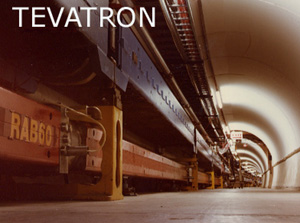The Tevatron 1979-1989

The Tevatron is the name for the system of high-energy accelerators at Fermilab. Its proton beam originates in the Cockcroft-Walton pre-accelerator from which it proceeds through the Linac (linear accelerator) to the Booster Ring. The beam's energy increases with each revolution and the beam is injected into the underground oval Main Injector where the energy is again raised higher and higher until it reaches 120 GeV (billion or giga electron volts). Finally, the protons are passed to the Energy Doubler/Saver where they are accelerated to the energy of 800 - 1000 GeV.
At this point two options become available: 1) the proton beam can be steered to the fixed target areas for experiments and data acquisition or, 2) the proton beam can collide with a beam of antiprotons travelling in the 4.26 mile circumference Tevatron in the opposite direction of the proton beam. The proton-antiproton collisions are the highest energy collisions possible on earth -- ~2 TeV (trillion electron volts). These collisions are detected at CDF and DZero.
The collections include all records of the Cockcroft-Walton, Linac, Booster Ring, Main Ring (the predecessor of the Energy Doubler-Saver), and the Main Injector. Documentation is supplemented with oral histories, photographs and videotape.
For a history of the Fermilab Energy Doubler see Lillian Hoddeson, "The First Large-Scale Application of Superconductivity: The Fermilab Energy Doubler, 1972-1983," Historical Studies in the Physical Sciences, 18:1 (1987), 25-54. Edited by Robert W. Seidel.


